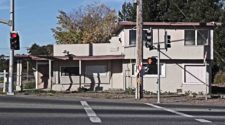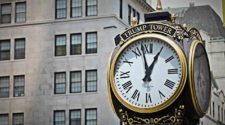Over the years, Puerto Rico has wooed visitors and investors with beaches, sun, tax breaks and splashy public works. Now the Caribbean island wants to add an outpost of Chinese culture, complete with graceful pavilions and regional cuisine.
The same territory that racked up more than $70 billion of debt has a new plan for spurring its long-suffering economy: have private investors build a $200 million China-themed center in Arecibo, on a former sugarcane field about an hour outside of San Juan. The investors, assembled by a Chinese law and development firm, plan to break ground in May and envision 39 structures to highlight foods, music, and entertainment.

Private investors plan on building a China-themed center on this empty land in Arecibo.
The plan, which must overcome both China’s new restrictions on foreign investment and the commonwealth’s checkered history of ambitious development, is part of a wider strategy to lure foreign money to a territory that defaulted and in May tumbled into bankruptcy. A decade-long recession has left the economy and infrastructure in dire condition, but years of excessive borrowing to fill budget gaps has shut the Commonwealth out of the municipal-bond market.
“Puerto Rico really cannot at this point go to the market and issue bonds and borrow money for public investment,” said Manuel Laboy, the island’s secretary of economic development and commerce. “It has to be based on private investment.”
Help From Abroad
Enter China. Puerto Rico is looking to capitalize on the nation’s recent global investment surge through its ‘One Belt, One Road’ infrastructure initiative that may fuel as much as $500 billion of international investment. The Americas — including some of Puerto Rico’s Caribbean neighbors like Cuba and the Bahamas — have already been a popular investment destination for Chinese companies for years.

Ricardo Rossello, center and executives stand for a photograph during a Chinese investment forum in Puerto Rico.
Puerto Rico officials plan to visit the country in September, a trip that follows a March investment forum in San Juan, where government officials met with more than 150 Chinese business people and Governor Ricardo Rossello gave the keynote address. Chinese investors have expressed interest in pharmaceuticals, tourism, manufacturing, power plants, road and bridge construction and recycling plants, Laboy said.
The Commonwealth for decades has tried to make itself attractive to business. An export-services incentive gives companies a 4 percent tax rate and exemptions on dividends and property levies. To boost tourism, the island gives tax credits and exemptions for hotels, time shares, theme parks and golf courses. Credits for hotel development are in the range of 40 percent, Laboy said.
Commonwealth Ventures
That backing doesn’t equal automatic success: The island needs more than a booming cultural park to reverse its slump. And Puerto Rico has a history of spending on jinxed projects. The Tren Urbano, a $2.25 billion commuter line that runs through San Juan, sells only a third of the rides that it needs and loses $50 million a year; an experimental nuclear plant operated only about four years before shutting down in 1968; and after years of development, the Port of the Americas in Ponce doesn’t operate enough business to repay about $226 million that it owes.
The disarray is reflected by the market. Some island securities have traded at pennies on the dollar and bonds from the Commonwealth’s last borrowing in March 2014 have dropped in value by 38 percent, changing hands Wednesday at an average 57.9 cents on the dollar, down from 93 cents when it was first offered.

There are hurdles as well on the other side of the Pacific. China this month set new rules on overseas investments, discouraging “irrational” acquisitions in industries ranging from real estate to hotels and entertainment — categories that would seem to include the Arecibo project. The drive is meant to reduce leverage in financial markets, and systemic risks and slow capital outflows that could weaken the nation’s currency.
Jeff Carmichael, chief executive officer of the Yingke Caribbean China Center, the regional outpost of the Chinese firm backing the project, said it isn’t subject to cash controls because of its cultural focus.
Still, there are several lures for the Chinese. Investing there allows Chinese nationals to win visas reserved for people who plow money into U.S. businesses, said Dahai Guo, chief executive officer of PuraCap Pharmaceutical LLC, a Chinese-owned company that makes generic medications in Dorado.
“China is interested in Puerto Rico not only for the beautiful island and the beaches,” said Guo, who was born and raised in China and moved to the U.S. in 1995. “China will consider the U.S. territory for the immigration law.”
Tapping a Load
PuraCap Caribe has invested more than $50 million since March 2016, doubling employment and increasing manufacturing more than 600 percent, Guo said.

An employee works at PuraCap Caribe lab on Aug. 29.
In 2016, Chinese businesses spent $46.2 billion on U.S. investments, more than three times the amount in the prior year, according to the Rhodium Group. Its citizens were the third-largest group of foreign visitors in 2015, behind travelers from the U.K. and Japan, and are expected to be the largest by 2021, according to the U.S. Travel Association. They spend an average $7,201 per visit, the most among foreign tourists.
“Even if we get a small percentage of that pie, for both foreign direct investment and the number of visitors from China tourism, we believe that is going to have a huge impact,” said Laboy, who has assigned two staff members to lure Chinese investments.
The interest appears mutual. Last November, Linda Yang, executive chairman of Yingke Global Holdings and a global partner in the associated Yingke Law Firm, came to Puerto Rico for the first time and toured the island by helicopter.
“We saw a lot of farmland that was still empty, so we believe there are opportunities,” she said in a telephone interview. “I really thought this could be a good place for Chinese investors.”
Plans for the firm’s Arecibo park, on a lush, green tract bounded by modest homes and the Rio Grande River, are still underway. Backers envision something similar to Orlando’s Epcot rising from the verdant undergrowth. The concept includes hotels and park-side condos for Chinese visitors and Sino-curious tourists too far from Beijing. The investors said they will meet in September with Puerto Rico officials to hammer out details of government support.
Yang’s firm, which has more 5,200 lawyers in 42 Chinese offices and another 2,000 in 88 offices abroad, has already acted on its convictions that Puerto Rico is an island of opportunity by opening the Yingke Caribbean China Center in San Juan last year. The facility is one of many regional hubs it has throughout the world to help business people connect with local partners, lawyers and accountants, and hosted the March investment forum.
“On the one hand, the bankruptcy gives some signals that there is some risk for this region. On the other hand, after the bankruptcy, it could be a new start, a new start with many new opportunities,” Yang said.
Many in China have never heard of Puerto Rico. Yang’s firm hopes the Arecibo park will change that. When tourists visit, perhaps they will also purchase a condo at one of the park-side developments also in the works or visit one of their manufacturing plants.
“Many times, Chinese combine business travel with personal travel,” said Carmichael. The park could become “a reason for an extended stay.”






